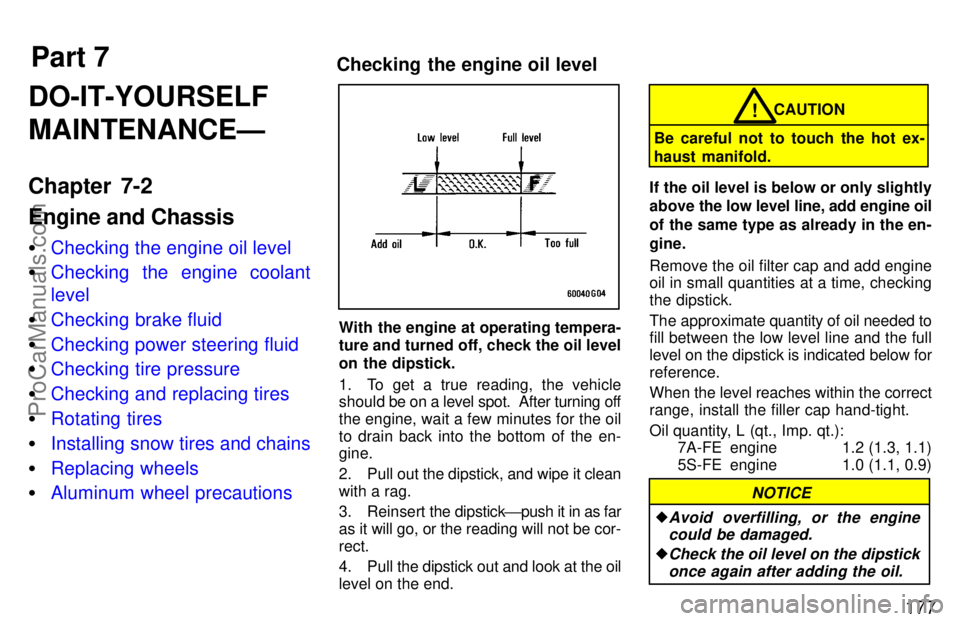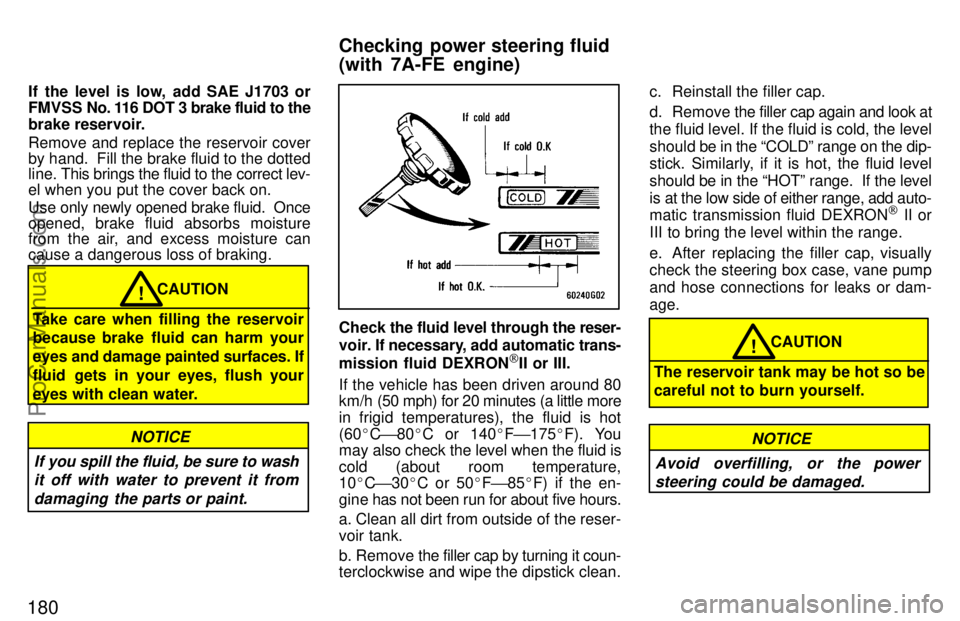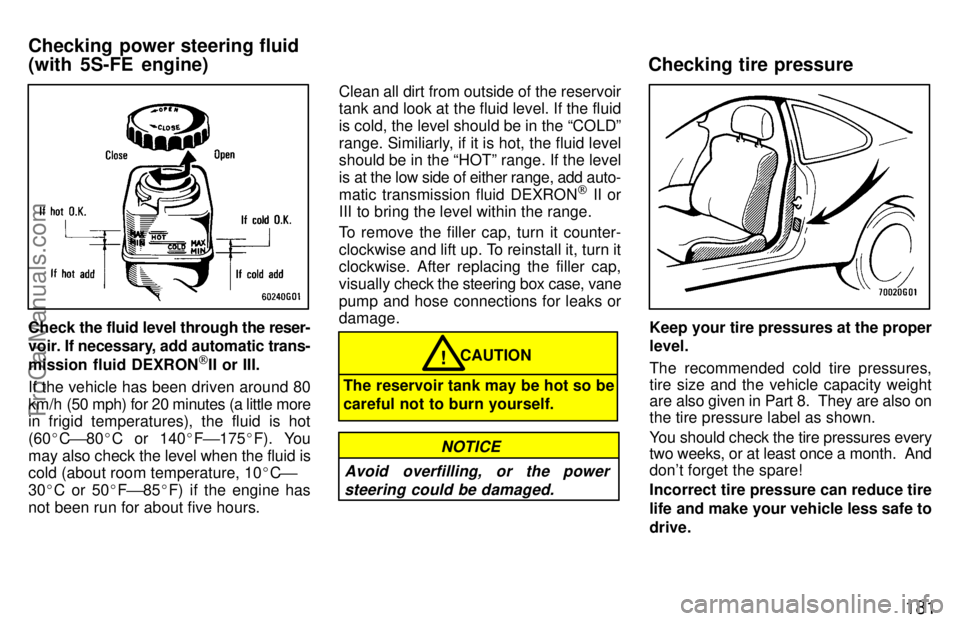Page 183 of 218

Part 7Checking the engine oil level177
DO-IT-YOURSELF
MAINTENANCEÐ
Chapter 7-2
Engine and Chassis
�Checking the engine oil level
� Checking the engine coolant
level
� Checking brake fluid
� Checking power steering fluid
� Checking tire pressure
� Checking and replacing tires
� Rotating tires
� Installing snow tires and chains
� Replacing wheels
� Aluminum wheel precautions
With the engine at operating tempera-
ture and turned off, check the oil level
on the dipstick.
1. To get a true reading, the vehicle
should be on a level spot. After turning off
the engine, wait a few minutes for the oil
to drain back into the bottom of the en-
gine.
2. Pull out the dipstick, and wipe it clean
with a rag.
3. Reinsert the dipstick'push it in as far
as it will go, or the reading will not be cor-
rect.
4. Pull the dipstick out and look at the oil
level on the end.
CAUTION
Be careful not to touch the hot ex-
haust manifold.!
If the oil level is below or only slightly
above the low level line, add engine oil
of the same type as already in the en-
gine.
Remove the oil filter cap and add engine
oil in small quantities at a time, checking
the dipstick.
The approximate quantity of oil needed to
fill between the low level line and the full
level on the dipstick is indicated below for
reference.
When the level reaches within the correct
range, install the filler cap hand-tight.
Oil quantity, L (qt., Imp. qt.): 7A-FE engine 1.2 (1.3, 1.1)
5S-FE engine 1.0 (1.1, 0.9)
�
Avoid overfilling, or the engine could be damaged.
�Check the oil level on the dipstick
once again after adding the oil.
NOTICE
ProCarManuals.com
Page 186 of 218

180
If the level is low, add SAE J1703 or
FMVSS No. 116 DOT 3 brake fluid to the
brake reservoir.
Remove and replace the reservoir cover
by hand. Fill the brake fluid to the dotted
line. This brings the fluid to the correct lev-
el when you put the cover back on.
Use only newly opened brake fluid. Once
opened, brake fluid absorbs moisture
from the air, and excess moisture can
cause a dangerous loss of braking.
CAUTION
Take care when filling the reservoir
because brake fluid can harm your
eyes and damage painted surfaces. If
fluid gets in your eyes, flush your
eyes with clean water.!
If you spill the fluid, be sure to wash it off with water to prevent it from
damaging the parts or paint.
NOTICE
Check the fluid level through the reser-
voir. If necessary, add automatic trans-
mission fluid DEXRON
[II or III.
If the vehicle has been driven around 80
km/h (50 mph) for 20 minutes (a little more
in frigid temperatures), the fluid is hot
(60 �C ' 80 �C or 140 �F ' 175 �F). You
may also check the level when the fluid is
cold (about room temperature,
10 �C ' 30 �C or 50 �F ' 85 �F) if the en-
gine has not been run for about five hours.
a. Clean all dirt from outside of the reser-
voir tank.
b. Remove the filler cap by turning it coun-
terclockwise and wipe the dipstick clean. c. Reinstall the filler cap.
d. Remove the filler cap again and look at
the fluid level. If the fluid is cold, the level
should be in the COLDº range on the dip-
stick. Similarly, if it is hot, the fluid level
should be in the HOTº range. If the level
is at the low side of either range, add auto-
matic transmission fluid DEXRON
[ II or
III to bring the level within the range.
e. After replacing the filler cap, visually
check the steering box case, vane pump
and hose connections for leaks or dam-
age.
CAUTION
The reservoir tank may be hot so be
careful not to burn yourself.!
Avoid overfilling, or the power steering could be damaged.
NOTICE
Checking power steering fluid
(with 7A-FE engine)
ProCarManuals.com
Page 187 of 218

181
Check the fluid level through the reser-
voir. If necessary, add automatic trans-
mission fluid DEXRON
[II or III.
If the vehicle has been driven around 80
km/h (50 mph) for 20 minutes (a little more
in frigid temperatures), the fluid is hot
(60 �C ' 80 �C or 140 �F ' 175 �F). You
may also check the level when the fluid is
cold (about room temperature, 10 �C '
30 �C or 50 �F ' 85 �F) if the engine has
not been run for about five hours. Clean all dirt from outside of the reservoir
tank and look at the fluid level. If the fluid
is cold, the level should be in the COLDº
range. Similiarly, if it is hot, the fluid level
should be in the HOTº range. If the level
is at the low side of either range, add auto-
matic transmission fluid DEXRON
[ II or
III to bring the level within the range.
To remove the filler cap, turn it counter-
clockwise and lift up. To reinstall it, turn it
clockwise. After replacing the filler cap,
visually check the steering box case, vane
pump and hose connections for leaks or
damage.
CAUTION
The reservoir tank may be hot so be
careful not to burn yourself.!
Avoid overfilling, or the power steering could be damaged.
NOTICE
Keep your tire pressures at the proper
level.
The recommended cold tire pressures,
tire size and the vehicle capacity weight
are also given in Part 8. They are also on
the tire pressure label as shown.
You should check the tire pressures every
two weeks, or at least once a month. And
don't forget the spare!
Incorrect tire pressure can reduce tire
life and make your vehicle less safe to
drive.
Checking power steering fluid
(with 5S-FE engine) Checking tire pressure
ProCarManuals.com
Page 212 of 218

206
Drive belt tension measured with Bor-
oughs drive belt tension gauge No.
BT-33-73F (used belt), Ibf:7A-FE engine
Generator belt 115 + 20
Power steering pump belt 80 + 20
Air conditioning compressor belt 100 + 20
5S-FE engine Generator belt Vehicles with air conditioning 155 + 20
Vehicles without air conditioning 95 + 20
Power steering pump belt 80 + 20
ENGINE LUBRICATION
Oil capacity (drain and refill), L (qt., Imp.
qt.): 7A-FE engine
With filter 3.7 (3.9, 3.3)
Without filter 3.5 (3.7, 3.0)
5S-FE engine With filter 3.9 (4.1, 3.4)
Without filter 3.7 (3.9, 3.3)
Oil grade:
API SH, Energy-Conserving IIº multi-
grade engine oil or ILSAC multigrade
engine oil is recommended. Recommended oil viscosity (SAE):
Temperature
range anticipated before next oil change
80040-L03U
COOLING SYSTEM
Total capacity, L (qt., Imp.):7A-FE engineWith manual transaxle 6.1 (6.4, 5.4)
With automatic transaxle6.6 (7.0, 5.8)
5S-FE engine
With manual transaxle 6.7 (7.1, 5.9)
With automatic transaxle7.1 (7.5, 6.2)
Coolant type: With ethylene-glycol antifreeze
(Do not use alcohol type.)
BATTERY
ÐMaintenance type battery Specific gravity reading at 20� C (68�F):
1.260 Fully charged
1.160 Half charged
1.060 Discharged
ÐNon-maintenance battery
Open voltage* at 20� C (68�F):
12.7 V Fully charged
12.3 V Half charged
11.9 V Discharged
*: Voltage that is checked 20 minutes
after the key is removed with all the lights
turned off
ProCarManuals.com
Page 213 of 218

207
Charging rates:Non-maintenance battery 5 A max.
Maintenance type battery Quick charge 15 A max.
Slow charge 5 A max.
CLUTCH
Pedal freeplay, mm (in.): 5' 15 (0.2' 0.6)
Fluid type: SAE J1703 or FMVSS No. 116
DOT 3
MANUAL TRANSAXLE
Oil capacity, L (qt., Imp. qt.): 7A-FE engine 1.9 (2.0, 1.7)
5S-FE engine 2.6 (2.7, 2.3)
Oil type:
Multipurpose gear oil API GL-4 or
GL-5
Recommended oil viscosity: SAE 75W-90
AUTOMATIC TRANSAXLE
7A-FE engine Fluid capacity (drain and refill),
L (qt., Imp. qt.):
Up to 3.1 (3.3, 2.7) 5S-FE engine
Automatic transmission
Fluid capacity (drain and refill),
L (qt., Imp. qt.): Up to 2.5 (2.6, 2.2)
Differential Fluid capacity, L (qt., lmp. qt.):
1.6 (1.7, 1.4)
Fluid type: Automatic transmission fluid D-II or
DEXRON
[III (DEXRON[II)
BRAKES
Minimum pedal clearance when de-
pressed with the pressure of 490 N (50
kgf, 110 lbf) with the engine running, mm
(in.): 7A-FE engine 75 (3.0)
5S-FE engine 80 (3.1)
Pedal freeplay, mm (in.): 1' 6 (0.04' 0.24)
Pad wear limit, mm (in.): 1.0 (0.04)
Lining wear limit, mm (in.):
1.0 (0.04)
Parking brake adjustment when pulled
with the force of 196 N (20 kgf, 44 lbf): 4-7 clicks
Fluid type:
SAE J1703 or FMVSS No. 116 DOT 3 STEERING
Wheel freeplay:
Less than 30 mm (1.2 in.)
Power steering fluid type: Automatic transmission fluid
DEXRON
[II or III
ProCarManuals.com